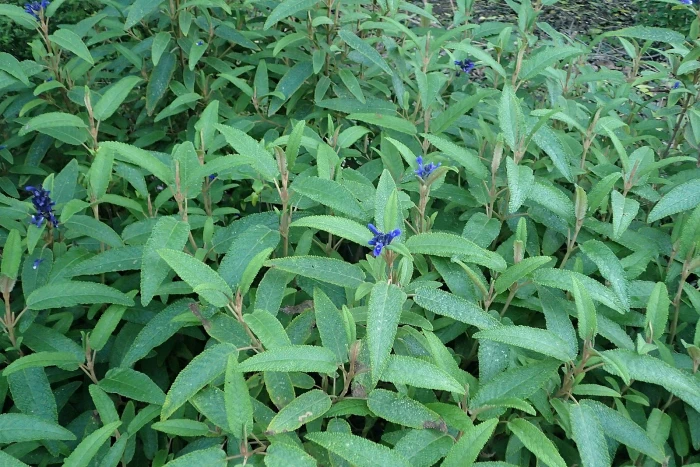Corrugated Sage
(Salvia corrugata)
Corrugated Sage (Salvia corrugata)
/
/

Krzysztof Ziarnek, Kenraiz
CC BY-SA 4.0
Image By:
Krzysztof Ziarnek, Kenraiz
Recorded By:
Copyright:
CC BY-SA 4.0
Copyright Notice:
Photo by: Krzysztof Ziarnek, Kenraiz | License Type: CC BY-SA 4.0 | License URL: https://creativecommons.org/licenses/by-sa/4.0 | Uploader: Kenraiz | Publisher: Wikimedia Commons |









Estimated Native Range
Climate Requirements for Des Moines, Iowa
| This Plant | Your Site | Plant Suitability for Your Location | ||
|---|---|---|---|---|
| • Precipitation | 29" - 35" | 34" | You should be able to grow this plant with no additional irrigation. | Excellent |
| • High Temp. | 56°F - 74°F | 87°F | Your summer temperatures are normal for this plant. | Excellent |
| • Low Temp. | 34°F - 53°F | 11°F | Your winter temperatures may be too cold for this plant | Too cold |
This plant may not grow well at your location - your winters are too cold.
Summary
Salvia corrugata, commonly known as Corrugated Sage, is an evergreen shrub native to the montane regions of Western South America, particularly in Peru and Colombia. It thrives in cool, moist conditions often found in cloud forests and on mountain slopes. This perennial shrub can reach up to 9 feet tall in its natural habitat, but typically grows to 5–6 feet in cultivation. It has a distinctive appearance with egg-shaped, deeply corrugated evergreen leaves that measure approximately 4.5 inches by 1.5 inches. The leaves are dark green on the top surface with light veining and covered with pale tan-colored fine hairs underneath, which may provide some drought resistance.
Corrugated Sage is celebrated for its striking purple-blue flowers, which are about 1 inch long and emerge from a small dark purple and green calyx. The flowers are arranged in congested whorls, with each 3–4 inch inflorescence bearing 6–12 flowers. Flowering occurs from late summer to fall, adding a splash of color when many other plants are beginning to fade. In addition to its ornamental value, the plant is also appreciated for its aromatic foliage and is sometimes used in traditional medicine. Corrugated Sage is suitable for border planting, as a specimen in a mixed shrubbery, or in a Mediterranean garden setting. It requires full sun to light shade, medium amounts of water, and well-draining soil to thrive. While generally easy to maintain, it can be susceptible to root rot in poorly drained soils and may require protection from frost in cooler climates.CC BY-SA 4.0
Corrugated Sage is celebrated for its striking purple-blue flowers, which are about 1 inch long and emerge from a small dark purple and green calyx. The flowers are arranged in congested whorls, with each 3–4 inch inflorescence bearing 6–12 flowers. Flowering occurs from late summer to fall, adding a splash of color when many other plants are beginning to fade. In addition to its ornamental value, the plant is also appreciated for its aromatic foliage and is sometimes used in traditional medicine. Corrugated Sage is suitable for border planting, as a specimen in a mixed shrubbery, or in a Mediterranean garden setting. It requires full sun to light shade, medium amounts of water, and well-draining soil to thrive. While generally easy to maintain, it can be susceptible to root rot in poorly drained soils and may require protection from frost in cooler climates.CC BY-SA 4.0
Plant Description
- Plant Type: Shrub
- Height: 2-3 feet
- Width: 1-3 feet
- Growth Rate: Moderate
- Flower Color: Blue
- Flowering Season: Summer, Fall
- Leaf Retention: Evergreen
Growth Requirements
- Sun: Full Sun
- Water: Medium
- Drainage: Medium
Common Uses
Bee Garden, Bird Garden, Border Plant, Butterfly Garden, Deer Resistant, Drought Tolerant, Fragrant, Hummingbird Garden, Low Maintenance, Rabbit Resistant
Natural Habitat
Montane regions of Western South America, particularly in cloud forests and on mountain slopes
Other Names
Common Names:
Scientific Names: Salvia corrugata, Alguelaguen gaudichaudii, Sphacele gaudichaudii
GBIF Accepted Name: Salvia corrugata Vahl